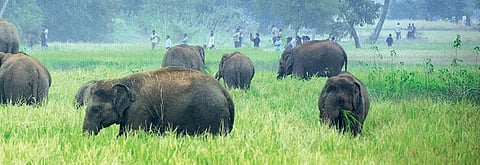

A heart-wrenching incident emerged from the Nagarhole National Park in Karnataka last December. A 42-year-old elephant died after getting stuck in a two-metre-high iron fence, set up by forest officials to prevent wildlife from entering human settlements. The elephant had reportedly crossed over the fence and raided nearby farms. When chased away, it tried to return but got stuck. While its death sparked criticism about the forest department’s strategy, the fact is human-elephant conflict has emerged as one of the most nagging conservation challenges in the country.
To drive away crop-raiding elephants, farmers resort to all sorts of ways, from beating drums and bursting crackers to erecting electric fences and using spikes and fireballs. Union government’s Project Elephant estimates that every year the conflict results in the death of over 100 elephants. Yet, they keep coming back to villages to raid farms or destroy barns. Why do elephants take the huge risk?
This could be because crops like paddy, corn, banana and jackfruit are superfoods for elephants. Eating these enhances their state of mind and well-being, says a study by post-doctoral researcher Sanjeeta Sharma Pokharel, her advisor Raman Sukumar, professor at Centre for Ecological Sciences, Indian Institute of Science (IISc), Bengaluru, and scientists at IISc’s Department of Molecular Reproduction and Developmental Genetics.
Since elephants face numerous threats while raiding crops, the team hypothesised that cropraiders would show higher stress levels compared to those in undisturbed forests. To test the hypothesis, between 2013 and 2015 they collected 394 faecal samples of non-raiding elephants in Bandipur-Nagarhole national parks and 208 samples from habitual crop-raiding elephants in agricultural areas of nearby Hassan district, and analysed those for faecal glucocorticoid metabolite (fGCM), a signature of stress hormone. What they found was counter-intuitive—crop-raiders were less stressed.
Perplexed, the researchers decided to delve deeper. According to Sreedhar Vijayakrishnan, elephant biologist at the National Institute of Advanced Studies, Bengaluru, dry-deciduous forests like Bandipur and Nagarhole become nutritionally scarce in certain seasons creating stress among elephants. On the other hand, an analysis of vegetation cover in the study showed better greenery in Hassan. “To cross-validate whether elephants were really getting better food from Hassan, we analysed the faecal samples for nitrogen content, which reflects the crude protein content in a herbivore’s diet,” says Pokharel. The faecal samples of crop-raiders had a higher nitrogen content than of the non-raiders dwelling in protected areas, says the study published in the October 2018 issue of Animal Conservation.
Though seasonality has a significant influence on the diet quality, the faecal samples of crop raiders had a higher protein content even in the dry season compared to their counterparts dwelling in protected forests. This is because crops provide more protein and certain minerals than forest forage. Though cultivation in Hassan is limited to a few perennial crops in the dry season, higher protein level in crop-raiders’ faeces may be due to the consumption of protein-rich plants or plant parts, notes the study paper.
When gain outweighs the risk
Crop raiding is definitely a high-risk, high-gain strategy for elephants, particularly for adult bulls, who are the first ones to explore non-forest agricultural areas to seek nutritious forage, explains Sukumar, also member of the National Board for Wildlife and Project Elephant. But better nutrition ensures that they grow bigger in size and outcompete other males for access to mates. Though females are cautious while raiding crops for the fear of exposing the herd to danger, they do follow the bulls into croplands after several years, possibly because of greater reassurance, increased competition within the natural habitat, and, of course, for the lure of crops, he says.
The study thus concludes that nutritional benefits obtained from crop raiding might contribute to reduction in stress levels in elephants in human habitats. However, there is a caveat.
In Hassan, elephants might be in less stress given the contiguity of forested landscapes and because the community is tolerant towards elephants, acknowledge the researchers. But this may not be the case in fragmented forested areas, where they are exposed to stressors such as chasing, harassing or the use of weapons.
Other researchers agree with the observation. “Bandipur-Nagarhole is a 10,000 sq km contiguous landscape. In contrast, Buxa, the largest forest track in north Bengal, spans only 700 sq km. It is further fragmented by transport infrastructure and surrounded by human habitation,” says Aritra Kshettry, INSPIRE fellow of the Department of Science and Technology. “Elephants in the extremely fragmented landscape could be under tremendous stress while searching for food and home.
It is easy for accidents to happen,” says N Lakshminarayanan, wildlife biologist at the Wildlife Institute of India, Dehradun. Previous telemetry studies in north Bengal, led by Sukumar, show elephants can track harvest season and congregate around human habitations during harvests. “It would be interesting to compare stress levels during harvest seasons when they are chased around more,” says Kshettry.
Large contiguous habitats and nutritious forage would certainly help minimise conflicts, says Sukumar. However, he cautions, wildlife managers have to stay prepared to tackle conflicts as some elephants will always go for crops, given their biology.
(The author is a conservationist with Human & Environment Alliance League, Kolkata)
(This article was first published in Down To Earth's 1-15 February, 2019 print edition)